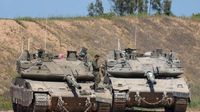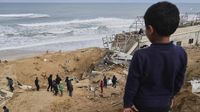The ongoing Israeli offensive on Gaza has tragically surpassed the harrowing threshold of 50,000 deaths, as reported by Hamas authorities. This news comes amidst a renewed campaign by the Israeli army that has drawn the Middle East back into full-scale conflict, following a fragile ceasefire lasting just under two months. Prime Minister Benjamin Netanyahu's government is sticking firmly to a military approach, despite rising international calls for dialogue.
As the Israeli Defense Forces (IDF) initiate its offensive in southern Gaza by encircling the Rafah district, the toll of war continues to rise. On March 23, 2025, an Israeli airstrike hit the Nasser Hospital in Khan Yunis, resulting in at least five deaths and numerous injuries, according to reports from Al Jazeera. The IDF confirmed responsibility for the assault, asserting they targeted a "key Hamas terrorist." Over the course of the military operations resuming since March 18, at least 673 Palestinians have lost their lives, as Israel has coupled aerial bombardments with cutting off electricity and water supply—actions met with international outcry over the humanitarian disaster affecting millions of Palestinians.
Netanyahu's goal remains clear: to compel Hamas to surrender and to facilitate the release of 58 hostages, both living and deceased, still held by the militants. The IDF's relentless pursuit has led to the deaths of key Hamas leaders. Among those reported killed was Salah al-Bardawil, another high-ranking official, as well as previous high-profile fatalities including Yasser Harb and Essam al-Dalis, head of the Hamas government in Gaza. The assault echoes at all levels; just last week the IDF expanded operations to include intense leafleting, instructing residents in the Tel al-Sultan neighborhood of Rafah to evacuate. Local sources shared harrowing accounts of panic as people fled, with one displaced individual reported saying, "They shot at us all night and ordered us to leave in the morning. Then they shot at us on the road."
The military's communication announced the completion of encirclement of Tel al-Sultan, in line with their aim to dismantle terrorist infrastructures and eliminate threats within the area. Despite the heavy toll, sirens in Tel Aviv alarmed citizens as missiles were launched from Yemen, reminding Israelis that the conflict isn’t contained to Gaza. Netanyahu's administration is unwavering in its military strategy toward Gaza and Lebanon, claiming responsibility for the killing of a Hezbollah member in recent operations.
This stance comes amid widespread calls for a ceasefire, notably expressed by global leaders, excluding the US administration under Donald Trump, which continues to support Israel’s hardline approach. Pope Francis has also expressed his profound "pain" about the resurgence of violence, urging weapons to be silenced.
As efforts for dialogue persist, Kaja Kallas, the EU High Representative, is scheduled to visit Israel on March 24, 2025, where she aims to advocate for a return to the ceasefire agreement and the release of hostages. During her visit, she will meet with President Isaac Herzog, Foreign Minister Gideon Sa'ar, and opposition leader Yair Lapid, followed by discussions in Palestinian territories with President Mahmoud Abbas and Prime Minister Mohammad Mustafa.
Nevertheless, Netanyahu's grip on power is bolstered by US backing for aggressive military action, reflecting a strategic partnership that has evolved into discussions of transforming Gaza into a Mediterranean "riviera," with plans to facilitate the voluntary departure of Palestinians from the enclave—an initiative that draws criticism and raises alarms regarding forced displacements and potential human rights violations.
The Israeli government has promptly greenlighted Defense Minister Israel Katz’s proposal, which aims at establishing a new ministry department responsible for helping Palestinians leave Gaza "voluntarily." As the world watches with concern, the humanitarian situation continues to deteriorate, adding urgency to calls from varied international bodies for restraint and compassion amid the conflicts.
The developments signify not only a humanitarian crisis but a complex matrix of policy decisions and military objectives. Amid the devastation, the underlying confusion about future reparations for Gaza and the Palestinian plight remains critical, as does the ongoing discourse about the possibility for peace and reconciliation in a region long marred by conflict.





